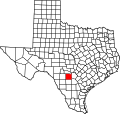Medina Dam | |
 Medina Dam in 2010 | |
| Nearest city | Castroville, Texas |
|---|---|
| Coordinates | 29°32′25″N98°56′2″W / 29.54028°N 98.93389°W |
| Area | 4.1 acres (1.7 ha) |
| Built | 1911 |
| Built by | Fred Stark Pearson |
| NRHP reference No. | 76002050 [1] |
| TSAL No. | 468 |
| Significant dates | |
| Added to NRHP | March 15, 1976 |
| Designated TSAL | May 28, 1981 |
The Medina Dam is a hollow-masonry type dam built in 1911 and 1912 by the Medina Irrigation Company in what became Mico, Texas, USA. Medina Lake extends north of it in northeastern Medina County and southeastern Bandera County. The dam and irrigation project was designed and financed by Dr. Frederick Stark Pearson, an American engineer, with extensive British financial backing. The construction took over 1500 men two years to build while working 24 hours a day. They were mostly skilled Mexican workers with experience building other dams for Pearson. They received two dollars for a day's work, which were good wages for the time. [2] [3] Pearson's Medina Irrigation Company (MICO) built a camp to house the workers and their families; the company town was first called MICO after its acronym. The community is now known as Mico, Texas.
Contents
- Historical State Markers on the Dam
- 1936 Mountain Valley marker
- 1978 Texas Historical Commission Marker
- 1991 Texas Historic Civil Engineering Marker
- Reopening of the Dam
- See also
- References
- Further reading
- External links
When the dam was completed in 1913, it was the largest hydraulic engineering project west of the Mississippi River and the fourth-largest dam in the US. [4] It is listed on the National Register of Historic Places for its significance as an infrastructure project and its contributions to economic development of the county. Author of Ripples from Medina Lake, Rev. Cyril M. Kuehne claims a total of 70 lives were taken during the dam's construction, however, he only managed to locate 27 death certificates. Dr. Oscar B. Taylor, dentist of near-by settlement Hondo, Texas, was quoted by Kuehne as saying "sixty-six [unmarked] graves" were counted at a cemetery 3 miles away. [5]
The dam contains over 292,000 cubic yards (223,000 m³) of concrete and measures 164 feet high by 128 feet (39 m) wide at the base by 1,580 feet (482 m) long. It is 25 feet (8 m) wide at the top, which is 1076.2 feet (328 m) above sea level, and the spillway is 1,064.2 feet (324 m) above sea level. [6] The dam provides irrigation to over 34,000 acres (138 km²) to Blackland Prairie farmlands below the Balcones Escarpment around Castroville, Texas, and also supplies water to the Medina River Ultrafiltration Water Treatment Plant owned and operated by the San Antonio Water System. [7]
The reservoir behind the dam is called Medina Lake and is a major recreation area. It discharges into the Medina River, which also contains a diversion dam four miles downstream.
The dam was featured in the 1919 serial The Masked Rider. [8]
Medina Dam was once a publicly accessible, one-lane roadway that connected to County Road 260. In 1980, vehicle traffic was closed and rerouted to a new road known as County Road 264; although temporary use of the dam as a road continued in 1990. [9]




